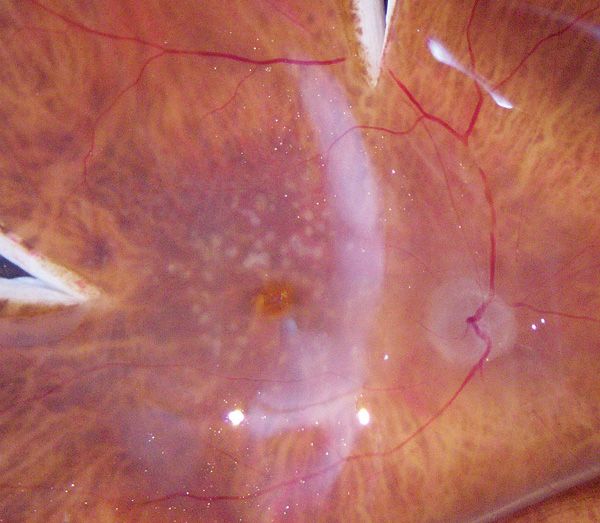Article
The value of human ocular tissue in research
Human ocular tissue has a critical role in helping researchers understand and find new treatments for diseases that include glaucoma, age-related macular degeneration, and cataract.
Take-home
Human ocular tissue has a critical role in helping researchers understand and find new treatments for diseases that include glaucoma, age-related macular degeneration, and cataract.
Eye on Research
About this series
Eye on Research is a quarterly series of articles highlighting cutting-edge ophthalmic research with the potential to have a significant effect on vision and ocular health worldwide. The series is supported by the Lions Eye Institute for Transplant and Research Inc. (LEITR), a nonprofit organization dedicated to the recovery, evaluation, and distribution of eye tissue for transplantation, research, and education. Located in Tampa, FL, LEITR is the only combined eye bank and ocular research center in the world. LEITR provides fresh donor globes, corneas, lenses, trabecular meshwork, and other tissues from diseased and healthy human eyes, often within 4 to 6 hours of death, to researchers for immediate use in their own labs or in its onsite research facility. For more information, contact info@LionsEyeInstitute.org or visit LionsEyeInstitute.org.
What role(s) do you foresee for human ocular tissue in research? Weigh in at Facebook.com/OphthalmologyTimes.
Most people think of donor eyes in the context of corneal transplantation-as well they should, given the tremendous success of transplantation in saving vision.
However, in the research community, there is an increasing recognition that ocular tissue also has a critical role to play in helping us understand and find new treatments for diseases, such as glaucoma, age-related macular degeneration (AMD), cataract, and more.
Glaucoma
In my laboratory, we have used donor tissue from the Lions Eye Institute for Transplant and Research (LEITR) to identify molecular and cellular pathways implicated in glaucoma pathogenesis.

(Figure 1) Cultured human trabecular meshwork cells. (Figure courtesy of Abbot F. Clark, PhD, FARVO)For example, we have been able to culture cells from human trabecular meshwork (Figure 1) and optic nerve head tissue to compare cells from normal eyes with those with glaucoma. We hope to do the same in the near future with retinal ganglion cells.
Other studies have been conducted with an organ culture model in which the anterior chamber is mounted and cultured for weeks. This has helped validate some of the signaling pathways initially identified in cultured cells, and given us a better understanding of the molecular mechanisms regulating IOP in the anterior chamber.
We have also been very successful in harvesting ribonucleic acid (RNA) from both cultured cells and the actual donor eye tissue to compare gene expression in normal versus glaucomatous eyes.
Ongoing research using all of these techniques continues to move us forward, closer to the ultimate goal of understanding what occurs early in the disease process of glaucoma, before there is irrevocable damage and vision loss.
Macular degeneration
There is exciting progress on AMD, as well. New techniques have dramatically altered what can be learned from a single tissue sample, said Robert F. Mullins, PhD, associate professor at the University of Iowa, Iowa City, and a faculty member at the university’s Institute for Vision Research.
“Ten years ago, studying a single gene might have been a master’s degree project,” he said. “But with today’s RNA analysis methods, we’re able to study the expression of 25,000 genes at once if we have high-quality, fresh tissue.”
Dr. Mullins’ team, working with the Iowa Lions Eye Bank, has imaged and genotyped more than 1,200 donor eyes in the past 8 years (Figure 2). Collecting research tissue on this scale is a huge undertaking and not something most eye banks or universities have made a commitment to, but Dr. Mullins believes it is well worth the effort.

(Figure 2) All donor eyes obtained by the University of Iowa Institute for Vision Research are prepared in a standard fashion. Gross photographs are obtained, as here. Some of the tissue is preserved in formaldehyde for histology and imaging, while other portions are frozen for future biochemistry studies. (Figure courtesy of Robert F. Mullins, PhD)“Although most human genes have a mouse ortholog, or equivalent gene, one exception is the ARMS2 gene, one of the major risk factors for AMD,” he said. “We are studying how this and other genetic polymorphisms that increase the risk for AMD affect the biochemistry of the eyes and how the expression of these genes in low-risk, high-risk, and diseased donor eyes differs.”
One lesson learned from Dr. Mullins’ tissue studies validates optical coherence tomography research that suggests choroidal abnormalities may precede RPE loss in early AMD.
“In the donor eyes with early AMD, there is a clear loss of choriocapillaris endothelial cells,” he said. “What that tells me is that the targets for future stem cell therapy interventions may actually be the choroidal vascular cells, rather than RPE cells.
“Further insights into what really causes AMD and how we might intervene are going to come from this kind of work on human ocular tissue,” Dr. Mullins said.
Cataract
In the field of lens research, scientists at Washington University in St. Louis, St. Louis, MO, are finding that studying vitreous degeneration in eye bank eyes has given them new insights into cataract formation.
“We tend to think of the vitreous as rather uninteresting, but it turns out that the degree of vitreous liquefaction is a better predictor of nuclear opacity than is age,” said David C. Beebe, PhD, professor of ophthalmology and cell biology at the university.
Dr. Beebe and his colleagues are working on compounds that could preserve and restore the structure of the vitreous body, as well as compounds that could be added to the lens to reverse age-related changes.
Here again, human tissue fills a critical need.
“The protein changes that slowly increase the stiffness of the human lens nucleus, contributing to presbyopia and cataracts, aren’t well reflected in any animal model,” Dr. Beebe said.
Unfortunately, he said, most basic scientists engaged in lens research have never even seen a human cataractous lens-something Dr. Beebe wants to change.
“In the mouse lenses we typically work with, cortical cataracts occur right on the surface of the lens,” Dr. Beebe said. “The first time I dissected a human lens with a cortical cataract, I immediately appreciated how different it was–the cataracts are deeper in the cortex, at the interface between hard nuclear cells and soft, healthy cortex,” he recalls.
“That completely changed my perspective on the role of physical damage to lens fiber cells in cortical cataract development,” he said.
Anterior segment surgery
Although cataract and refractive surgeons might not think of their bread-and-butter procedures as being based on donor eye studies, it would be impossible to perform these procedures without irrigating solutions, viscoelastics, and topical antibiotics-all of which have been extensively studied in human eye bank eyes.
“To determine that phacoemulsification could be tolerated by a 70- or 80-year-old human corneal endothelium, we had to test it in human tissue,” said Henry F. Edelhauser, PhD, professor of ophthalmology, Emory University, Atlanta.
Today, the safety of phaco is well established, but tissue studies continue to be valuable in evaluating new femtosecond laser technology.
Drug delivery is another area of interest for Dr. Edelhauser.
“Certainly for any topical medication, the cornea plays an important role,” he said. “We want to know how well the drug penetrates the cornea, where it accumulates, and whether it is toxic.”
Although the initial screening of drug candidates and formulations can be done in animal eyes or other laboratory models, testing must be replicated in donor eyes to ensure a similar rate of diffusion through the human cornea.
Dr. Edelhauser’s current research focuses on delivery methods that bypass the cornea altogether. Using donor eyes from LEITR, he and his team are using a microneedle to inject into the suprachoroidal space (between the sclera and choroid) to see how various agents spread to the retina. This technology could potentially make injection of anti-vascular endothelial growth factor agents, for example, safer and more efficient. Innovative new microbeads and nanoparticles for a range of sustained-release therapeutic applications are also being tested in human tissue.
"The FDA is already moving away from animal-only studies," said Jason K. Woody, president and chief executive officer of LEITR. "We believe that human ocular tissue will be the driving force for drug discovery and pre-clinical research models in the future."
Meeting the need
From this sampling of research endeavors, the value of ocular tissue in advancing scientific knowledge of ocular diseases is clear. The United States has a very strong network of eye banks and a cultural climate that supports the use of donor tissue for research. Nevertheless, there remain many challenges.
Organ and tissue donation rates, especially among ethnic groups that are disproportionately affected by ocular disease, are lower than desired. Few eye banks have dedicated resources to obtain and characterize research tissue. And many researchers do not even consider ocular tissue in designing their experiments. Finally, changes in donor eye procurement and broadening of eligibility for transplant have, to some degree, made it more challenging for researchers to obtain the tissue needed for scientific studies.
Organizations like LEITR that emphasize both transplantation and research help to bridge the gap and highlight the importance of such research. In the future, it is hoped that there will be an even greater awareness of how clinicians and scientists can collaborate to make the best use of the great gift of ocular tissue.

Dr. ClarkAbbot F. Clark, PhD, FARVO, is professor of cell biology and anatomy at the University of North Texas Health Science Center and director of the university’s North Texas Eye Research Institute in Fort Worth, TX. He receives research grant support from the National Eye Institute, Department of Defense, Alcon Research Ltd., and the Lions Eye Institute for Transplant and Research. Readers may contact him at 817/735-2094 or Abe.Clark@unthsc.edu.
Subscribe to Ophthalmology Times to receive the latest clinical news and updates for ophthalmologists.
Newsletter
Don’t miss out—get Ophthalmology Times updates on the latest clinical advancements and expert interviews, straight to your inbox.




